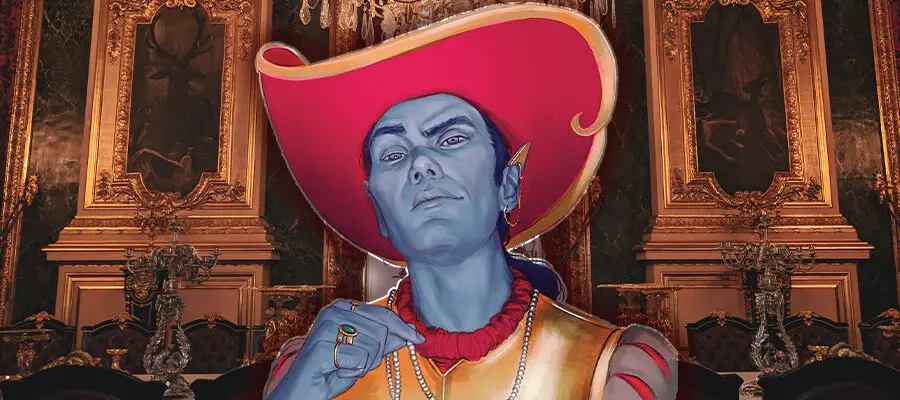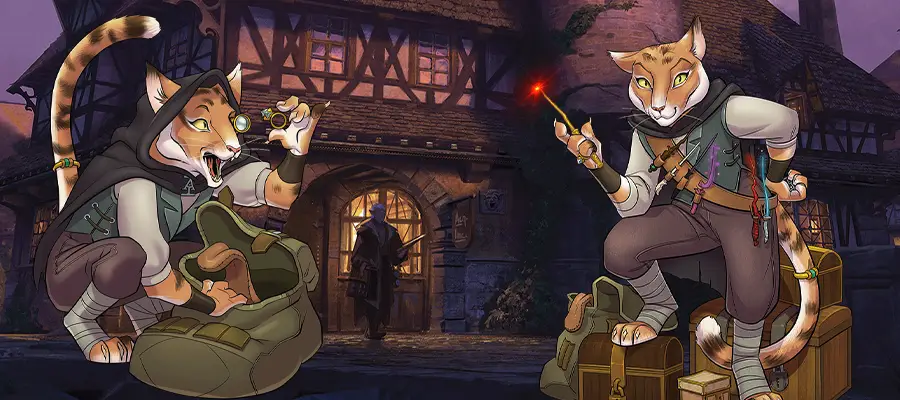This article’s featured image for D&D 5e Bard Subclass Ratings Ranked Best to Worst is a combination of images from Candlekeep Mysteries and Sigmund at Unsplash. This article contains affiliate links that add gold to our coffers.
D&D 5e’s Bard is far different from past editions’ versions of the class. Making the Bard a full spellcaster (which it wasn’t in the 5e playtest) while still leaning into the Jack of All Trades angle is a complete transformation and power boost to the class. Interestingly, the class feels less musical and more magical in D&D 5e.
Now that Bard is a full spellslinger, how do its subclasses shake out? They only get three instances of features at levels 3, 6, and 14, so I hope they’re useful! Not all subclasses are created equal, so let’s dive into each one to weigh their pros and cons!
Premise and Rating System
I’m rating each subclass based on the game overall for Bards only, so I’m not comparing a Bard subclass to an Artificer subclass. That wouldn’t feel fair. I also rate each subclass based on five criteria:
- High-level Functionality: How well the subclass functions and keeps up with other options beyond level ten.
- Low-level Functionality: How well the subclass functions and keeps up with other options between levels one to nine. The subclass might be a strong multiclass dip option.
- Versatility & Fun: The subclass offers multiple ways to play it without making a player feel stuck. Features are enjoyable and cohesive.
- Design & Accessibility: I favor character options that are easy to understand and use. If they’re innovative and unique to other character options in the game, even better. A subclass that reinvents or reinvigorates neglected game mechanics receives top marks.
- Lore & Roleplaying: Subclasses that evoke fantastic stories, can be flavored in a variety of ways, and are easy to imagine conceptually.
This clearly isn’t a science, but it’s the system that works for me! It also helps me to be objective and not feel burdened by community perceptions.
Quick Poll: Favorite Bard Subclasses from the 5e Community
Before or after you read through my Bard subclass ratings, let us know which is your favorite! Voting will reveal the votes of others, too.
Skip to Your Favorite Bard Subclass Rating
— Creation
— Eloquence
— Glamour
— Lore
— Spirits
— Swords
— Valor
— Whispers
Creation Bard Subclass (TCoE)
Summary of subclass features: Use Bardic Inspiration to give an ally a mote that can be used for ability checks, attack rolls, and saving throws with additional effects based on the roll type it’s used with. Create nonmagical items. Animate an object with its own custom stat block. Eventually, enhance your ability to create items by ignoring gold cost limitations and creating more at once.
- High-level Functionality: ★★★★
- Low-level Functionality: ★★★★★
- Versatility & Fun: ★★★★★
- Design & Accessibility: ★★★
- Lore & Roleplaying: ★★★★★
Flutes’ Evaluation (5/5):
This subclass is surprisingly interesting. It can use Bardic Inspiration in unique ways while creating and animating objects. These are the types of features that seem to complement a creative Bard player.
There are subtly smart design choices here, such as commanding the animated item with the same bonus action as using Bardic Inspiration. This detail means the Bard won’t have to choose between using its helper and helping allies.
Requiring players, especially new players, to look up and understand items can be cumbersome. I see room for DMs to say “no” to a lot of ideas if the player and DM don’t sync up.
I love the imagery of a Bard who brings objects to life. It feels fantastical and interesting to consider the Creation Bard’s possibilities.
Eloquence Bard Subclass (TCoE)
Summary of subclass features: Treat your Persuasion and Deception ability check rolls of nine or lower as tens. Use Bardic Inspiration as a bonus action to give a creature disadvantage on its next saving throw before your next turn. Bardic Inspiration given to allies is not expended if it contributes to a roll that still fails. Makes creatures magically understand your language as you speak. Use a reaction when an ally succeeds with your Bardic Inspiration to give another ally a use of Bardic Inspiration (which does not expend your uses of BI).
- High-level Functionality: ★★★★
- Low-level Functionality: ★★★★★
- Versatility & Fun: ★★★★★
- Design & Accessibility: ★★★★★
- Lore & Roleplaying: ★★★
Flutes’ Evaluation (5/5):
This subclass is nuts! It comes with early skill floors and debuffs to enemy saving throws. Then it gets language surpass and one of the best buffs to Bardic Inspiration at level six. Keeping Bardic Inspiration until it aids a success is incredible.
At high levels, this Bard can spread Bardic Inspiration like wildfire through a party if it keeps its reaction free. Reactions become valuable resources at high levels, so this can be challenging to utilize effectively.
Despite its power, the Eloquence Bard is surprisingly straightforward and accessible. It’s elegantly easy to use while remaining notably effective.
My primary criticism of the Eloquence Bard is that its theme is shaky compared to other Bard Colleges. It’s a minor nitpick, though. The Eloquence Bard is very strong, bordering on absurd to many critics.
Glamour Bard Subclass (XGtE)
Summary of subclass features: Give temporary hitpoints to allies as a bonus action that also allows them to move as a reaction without provoking opportunity attacks. Charm people into idolizing you for a while when you speak to a group, and they unknowingly fail their Wisdom saves. Transform as a bonus action to gain the ability to cast Command as a bonus action for one minute while you concentrate on your transformation. While transformed, creatures charmed by you automatically fail their saving throw against your Command spell. You eventually gain another transformation that causes enemies to make Charisma saves to succeed in attacking you; those who succeed on the save have disadvantage to save against your spells on your next turn.
- High-level Functionality: ★★★★
- Low-level Functionality: ★★★★
- Versatility & Fun: ★★★
- Design & Accessibility: ★★★★★
- Lore & Roleplaying: ★★★★★
Flutes’ Evaluation (4/5):
This is an interesting one. Charming a crowd after a brief performance can be amazing, but the reason to do this will be circumstantial. Giving nearby allies temporary hit points and a burst of movement can be helpful as a bonus action. These are functional features for low levels, but they don’t excite me much.
Once the subclass gets Mantle of Majesty, the possibilities really open up. Creativity is rewarded by this sort of combination with Enthralling Performance. It’s rare to guarantee success, and the setup is fairly safe. Casting Command can shut down an enemy during a fight when you can do it as a bonus action each turn. If you charm someone with Enthralling Performance, you can do horrible things. After all, enchantment and charm are amongst the evilest things in the game in devious hands. It’s good that it requires concentration, which isn’t something I say often of features that require concentration.
Unbreakable Majesty is interesting because there may be times when you hope an enemy succeeds at the saving throw. That’s because forcing disadvantage on your next spell on your next turn could be a massive opportunity. If they fail, they can’t attack you! It’s notable that enemies immune to charm won’t ignore this feature.
This subclass is highly dependent on charms, so there will be a learning curve for creatures who can ignore the subclass features. It’s not the most versatile subclass, and it has a bit of a slow start, but it shakes out to be really cool. The lore behind this fey-like Bard subclass is approachable and easily understood.
I love an enchantment specialist, so I can see the possibilities embedded in this subclass.
Lore Bard Subclass (PHB)
Bonus proficiencies: Three skills.
Summary of subclass features: React with a Bardic Inspiration die to reduce an attack roll, damage roll, or ability check. Bonus dose of early Magical Secrets. Freely add Bardic Inspiration to any ability check you make if you roll lower than you’d like.
- High-level Functionality: ★★★
- Low-level Functionality: ★★★
- Versatility & Fun: ★★★★★
- Design & Accessibility: ★★★★
- Lore & Roleplaying: ★★★
Flutes’ Evaluation (4/5):
I know this is a well-loved Bard subclass, but it bores me. I don’t have the same love for Magical Secrets that other players harbor; I’d rather play a Wizard or Cleric and use their spells. The bonus proficiencies are nice but uninspiring.
Cutting Words, however, is a cool feature. I appreciate how it can be used in a variety of ways.
Peerless Skill doesn’t wow me, but I like that it can apply to Initiative. It doesn’t require a reaction, either. I respect that.
I don’t think the subclass entirely feels like a lore specialist. To me, it halfway lives up to the “lore” name. I wish it focused less on skill checks to justify the lore specialty.
If you think you can change my mind as to why the Lore Bard should outrank other subclasses, let me know. I’ll gladly hear your point of view. I can’t guarantee I’ll change my mind, though! For now, it barely squeaks by into the four-star ranking.
Spirits Bard Subclass (VRGtR)
Bonus cantrips: Guidance cantrip (extended to 60 feet).
Summary of subclass features: Use spooky items as your spellcasting focus and eventually enhance your spells by doing so. Roll on a table of tales to activate special effects with your Bardic Inspiration. Perform a ritual with allies to learn a spell from any spell list with a level equal to the number of participants in the ritual. Eventually, gain more control over your Spirit Tales rolls.
- High-level Functionality: ★★★
- Low-level Functionality: ★★★★
- Versatility & Fun: ★★★★★
- Design & Accessibility: ★★
- Lore & Roleplaying: ★★★★
Flutes’ Evaluation (4/5):
I love the theme they chose with this design… but the mechanics make me scratch my head. Tales from Beyond is supposed to define the playstyle, but each option is wildly different from the others. This is like a wild magic Bard.
Spirit Session at level six is very cool. I love the seance feel of it to learn a spell and how the feature rewards you for having other characters join the seance. My preference lays with this feature over Lore Bard’s extra Magical Secrets.
I don’t like high-level subclass features that only make lower-level features more consistent. It’s strange because the randomness at low levels appeals to many players (like wild magic, as I said). Making the features less random at high levels appeals to people who don’t like wild magic, but those players probably wouldn’t pick this subclass. Those who enjoy the subclass at low levels may feel like Mystical Connection is a waste of a feature.
A glaring problem with this subclass is how it fails to interact with Bard’s spellcasting focus correctly. Also, the 30-foot range of Tales from Beyond can clash directly with some of the random effects.
Oh, and Guidance at range can be annoying, but it’s a fantastic cantrip. I can’t argue that Guiding Whispers is nice at low levels!
My rating here ties with Lore Bard, so my bias is the deciding factor. I like the College of Spirits more!
Swords Bard Subclass (XGtE)
Bonus proficiencies: Medium armor, scimitars.
Summary of subclass features: You can use a weapon you’re proficient with as a spellcasting focus. Learn one of two Fighting Styles. Gain special Blade Flourishes and increase your movement speed for the turn when you attack. Extra Attack. Blade Flourishes use your Bardic Inspiration until level fourteen, when they can perpetuate themselves with 1d6.
- High-level Functionality: ★★
- Low-level Functionality: ★★
- Versatility & Fun: ★★
- Design & Accessibility: ★★★
- Lore & Roleplaying: ★★★
Flutes’ Evaluation (2/5):
Another unpopular opinion; I really don’t care for this subclass. I think its features are mostly traps that can get a spellcaster in trouble. The best part of this subclass is medium armor proficiency and a boost to AC, but I’d rather just play a Valor Bard or take a feat for that. Plus, Valor gets shields.
This is mostly a multiclass dip for other Charisma-based casters. I would never play this subclass straight through on its own. I hate that it only gets Extra Attack at level six because I’d almost never want to be in melee. This subclass can’t use Booming Blade with the flourishes since they depend on using the Attack action.
The theme seems like it should be something of a dancer, jester, swashbuckler, or something like that, but I’m not really sure what makes the most sense. It’s a little too ambiguous for my taste.
I honestly consider this subclass to be a trap. I don’t recommend it.
Valor Bard Subclass (PHB)
Bonus proficiencies: Medium armor, shields, martial weapons.
Summary of subclass features: Use Bardic Inspiration for damage or defensive AC boosts. Extra Attack. Make a bonus action attack after casting a Bard spell.
- High-level Functionality: ★★★
- Low-level Functionality: ★★★★★
- Versatility & Fun: ★★★★
- Design & Accessibility: ★★★★
- Lore & Roleplaying: ★★★
Flutes’ Evaluation (4/5):
I prefer Valor Bard over the Swords Bard, but both of them are somewhat overshadowed by the Hexblade Warrior. Medium armor and shield proficiencies provide huge value from these subclasses, but Hexblade does it with one level.
Combat Inspiration is fantastic as something to save until landing a critical hit or needing a reaction to boost AC a bit. Extra Attack at level six and martial weapon proficiency at level three feel like wastes. It’s too easy for Bards to grab Eldritch Blast and cast that instead.
Battle Magic also is disappointing at level 14. Newer subclasses of 5e learned that this sort of feature is better at lower levels. However, this could be useful if you can juggle your spell components and a weapon while using a feat like Sharpshooter. It’s interesting and unique for a spellcaster, though new players may fall into traps in the mechanics that disappoint them.
The Valor theme is dull, but it’s clear. You’re a Bard who trains to be a part-time warrior. This subclass clearly didn’t appeal to players of 5e as a gish (spellcasting warrior), but this subclass is solid. Sometimes AC and options are good enough.
Whispers Bard Subclass Ratings (XGtE)
Summary of subclass features: Deal extra damage with psychic blades when you attack once per turn by expending a Bardic Inspiration. Speak to someone for one minute to attempt to frighten them (they don’t know if they succeed on the Wisdom save). Grab someone’s shadow when they die so you can impersonate them and learn information from the departed. Whisper to someone and convince them that you know their greatest secret, terrifying and charming them into obeying your requests.
- High-level Functionality: ★★
- Low-level Functionality: ★★★★
- Versatility & Fun: ★★★
- Design & Accessibility: ★★★
- Lore & Roleplaying: ★★★
Flutes’ Evaluation (3/5):
This subclass suffers from design deficiencies. Psychic Blades is the feature that sticks out as wanting to define the subclass, but the subclass doesn’t do much to incentivize going into melee as a spellcaster. I believe Psychic Blades would’ve been fine to allow more than once per turn and on other creatures’ turns.
Words of Terror is the other feature that defines the subclass. I compare it to the College of Glamour, but with frightening a single creature. The problem is that frightening a creature isn’t as useful out of combat as charming them. The DM could make it worthwhile, which I’ve seen my DM do for a Whispers Bard in my party, but I can’t think of a memorable instance of it.
Mantle of Whispers, in my experience, is the real reason to pick this subclass. It could be reproduced with the Disguise Self spell, but gaining information from the dead creature is notable. There are stipulations to prevent you from spamming this ability, which I think is unnecessarily restrictive.
Shadow Lore is disappointing because low-level spells can effectively get the same result. Those spells don’t require a common language, either.
This subclass theme feels messy and incongruent with its mechanics.
Bard Subclass Rankings Best to Worst
- Eloquence
- Creation
- Glamour
- Valor
- Spirits
- Lore
- Whispers
- Swords
I won’t surprise many with my top placements for Eloquence and Creation. My low treatment of Lore will surprise and possibly offend, haha. Swords might also shock people. I bet my esteem for Valor will be unpopular, as well.
What is the worst Bard subclass?
The College of Swords is the worst Bard subclass. It’s bland, with bad scaling and misleading mechanics for a spellcaster.
What is the best Bard subclass?
The College of Eloquence is the best Bard subclass. It has incredible consistency, useful utilization of core Bard features, and spellcasting synergy. The College of Creation is also excellent, unique, and thematic.
Conclusion
Which of my ratings did you agree or disagree with most? Do you want to second my rankings or challenge them? Cast Message in the comments below to discuss Bard subclasses with me!
You can read more of our content about D&D 5e Bards here. Thanks for reading, and have a fantastic adventure this weekend.





I disagree with the college of whispers ranking I made them into a versatile and deadly combatant. I did it by taking the sharpshooter feat and a few levels rogue. This adds sneak attack damage to psychic blades, allows you to ignore most cover and add 10 extra damage to your attacks at a -5 penalty to the roll.
Lets not forget it is possible to coat your crossbow bolts for even more damage. It becomes a deadly burst damage sniper that scales as you level. They are a powerhouse when it comes to ranged combat and have a massive damage output.
I’m glad to hear you’re enjoying the College of Whispers as a ranged attacker!